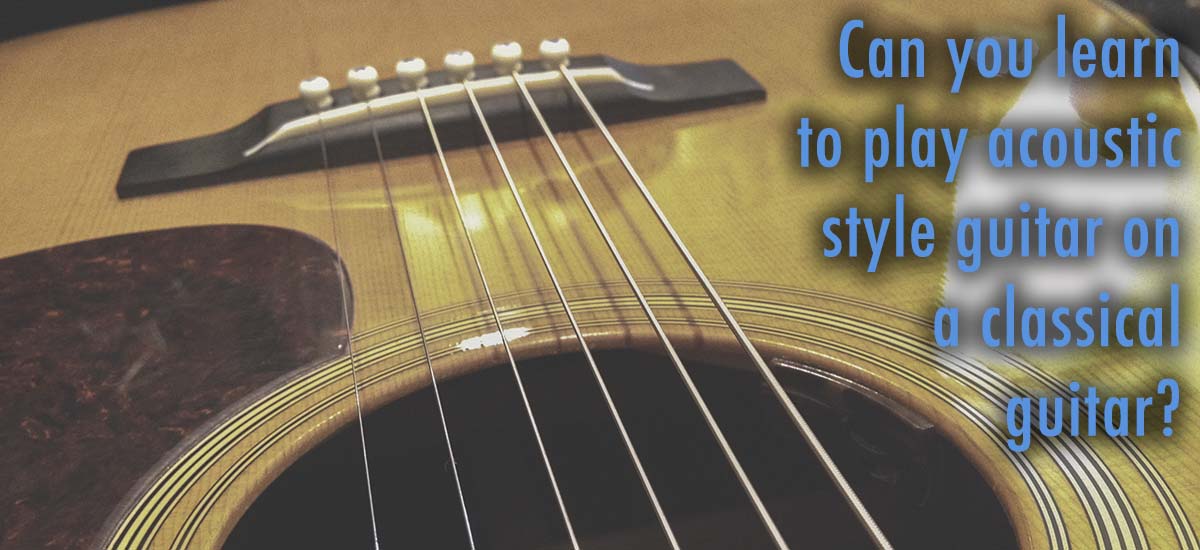This is a question I’d get quite often when teaching guitar lessons. Most of the time it was coming from beginners who had been gifted an old classical guitar and they were hoping that it would work for learning to play.
Recommended Article: How to Buy the Best Beginner Guitar
A classical guitar is perfectly fine to start out on for a beginner. And in some ways, it can be a better option for younger players.
There are quite a few programs that start young players on classical guitar learning to read music. This is incredibly valuable and if they stick with it, they will have progressed considerably ahead of non-music reading players.

I equate this entrance into the guitar world to taking piano lessons as a child. It is structured and rigid, which helps teach children discipline in their approach to the guitar. However, motivation can become an issue, and if the parents don’t insist most kids will go with a guitar teacher who will teach them whatever song they want to learn (Sure you want to learn another Metallica song?)
But that wasn’t really the question. Yes, a guitar played in classical style is the appropriate guitar to learn on, and a particularly great option for children. But what if you have a classical guitar and want to play standard acoustic style on it?
By “standard acoustic style” I mean strumming with a pick, fingerpicking, chording (including barre chords), and single line runs.
There are 3 main differences and reasons why a classical guitar isn’t going to work well for the standard acoustic style application.
Strings
Classical guitars use nylon strings that have a very beautiful and mellow tone to them. This translates great to classical and jazz, but not that great to most other styles of music.

The bottom three strings (E,A,D), on a nylon string set are nylon fibers that have a wound wrap. It does not take much abuse to start unwinding the string, and a using a pick is a great way to do that. Once the strings starts to unwind it’s immediately useless and will unravel very quickly.
Lastly, classical strings don’t promote the development of the calluses that you need to play guitar standard steel string acoustic style. This is just something that all players have to go through. It will be painful for a couple weeks, but soon you’ll have fingertips of steel that can handle playing for hours on end. Don’t be a wimp and play a classical just because your fingers hurt.
Neck Radius
Classical guitar necks are fat and their fretboards are flat. That’s not a diss, it’s just the way they’re built.
If you imagine a circle and the cross-section of the guitar neck on the inside butting up against the circle line, that describes the radius of the fretboard. For a classical guitar, that doesn’t exist as there is no radius.
But for acoustic and electric guitars, the fingerboards are curved. The reason for this is for ease of playing. Typically speaking, acoustic guitars have around a 12” – 16” radius while electric guitars can be as little as 7 ¼” and as high as 16”.
Again, the radius in the fretboard makes it much easier to play. And while a classical guitar is built for classical style, playing traditional acoustic style on it can be incredibly difficult.
Action
There is considerably less tension on a strung classical guitar than on a steel string acoustic guitar. This is because of the difference in the string type. Because of lower string tension, the strings on a classical guitar need to be higher off the fretboard in order not to buzz on the frets while being played.

The higher action of a classical also plays into the stylist needs that influence the technique of classical guitar playing. This high action is going to be difficult for someone who’s trying to learn how to chord and then make chord changes quickly.
And while the strings are softer, the higher action makes up for that causing stress on the fingers in a different way than experienced with a traditional acoustic.
HOWEVER
There are many guitar players who use classical guitars in the more standard fashion. Most famous and recognizable of these is Willie Nelson. Here he is, strumming his famous worn old Martin classical “Trigger”, pick and all.

Best Acoustic Guitar for Beginners
If you fall into the category of a beginner who is wondering if they can use a classical guitar they already have to learn, I would suggest buying an inexpensive beginner guitar. There are some great options that will make learning to play much easier and will keep you excited instead of frustrated. Check out this post on the best acoustic guitars for beginners.
Keep sending in questions, and make sure you pick up that guitar today!
